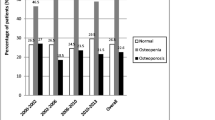Abstract
Summary
Reducing overuse of tests such as dual-energy X-ray absorptiometry (DXA) scans in younger women is an important quality issue. We evaluated trends in DXA ordering before and after Choosing Wisely recommendations were released. We found no significant difference in ordering trends suggesting that other initiatives are needed to change behavior.
Introduction
Reducing overuse of tests such as dual-energy X-ray absorptiometry (DXA) scans in younger women is an important quality issue, but trends in care are difficult to change. We evaluated (1) trends in DXA ordering before and after the Choosing Wisely recommendation release and (2) patterns of key characteristics that indicate a potentially appropriate DXA scan order.
Methods
We performed a retrospective longitudinal analysis of electronic health record data at a multi-specialty, ambulatory care network of 34 practices across Maryland and Washington, DC. Since the Choosing Wisely DXA recommendation was released April 2012, the study periods were April–December 2011 (pre-initiative) and April–December 2012 (post-initiative). Women between 50 and 64 years with primary care encounters, and primary care providers who saw ten or more women in the study population in both pre and post periods were included.
Results
For 42,320 eligible patients, the mean provider ordering rate was 2.6 % pre-initiative and 2.0 % post-initiative; there was no significant difference in trend over time. Over 70 % of the population had no characteristics associated with potentially appropriate DXA ordering. Low body mass index, current smoker status, and osteopenia were the most common characteristics indicating potentially appropriate DXA orders. Patients with any of these three characteristics had DXA ordering rates between 3–20 %.
Conclusions
The trend in provider ordering rates of DXA scans did not decrease after the release of the DXA Choosing Wisely recommendation. Targeted initiatives addressing providers with high ordering rates will be needed to change behavior.
Similar content being viewed by others
References
Chan KS, Chang E, Nassery N, Chang HY, Segal JB (2013) The state of overuse measurement: a critical review. Med Care Res Rev 1077558713492202
Lipitz-Snyderman A, Peter PB (2013) Overuse of health care services: when less is more… more or less. JAMA Int Med 173(14):1277–1278
Lawson EH, Gibbons MM, Ingraham AM, Shekelle PG, Ko CY (2011) Appropriateness criteria to assess variations in surgical procedure use in the United States. Arch Surg 146(12):1433–1440
American Board of Internal Medicine (2014) Choosing Wisely ® http://www.abimfoundation.org/initiatives/choosing-wisely.aspx Accessed Oct 15
Wolfson D, John S, Lorie S (2014) Engaging physicians and consumers in conversations about treatment overuse and waste: a short history of the Choosing Wisely campaign. Acad Med
American College of Rheumatology (2014) Position statement: bone density. https://www.rheumatology.org/Practice/Clinical/Position/Position_Statements/ last accessed Oct 20
US Preventive Services Task Force (2014) Osteoporosis screening http://www.uspreventiveservicestaskforce.org/3rduspstf/osteoporosis/osteorr.pdf. Accessed Oct 15
Kale MS, Bishop TF, Federman AD, Keyhani S (2011) “Top 5” lists top $5 billion. Arch Intern Med 171(20):1858–1859
Schnatz PF, Marakovitz KA, DuBois M, O’Sullivan DM (2011) Osteoporosis screening and treatment guidelines: are they being followed? Menopause 18(10):1072–1078
Centers for Medicare and Medicaid Services (2010) 2010 PQRI measures list. Retrieved from http://www.cms.gov/PQRI/Downloads/2010_PQRI_MeasuresList_111309.pdf
Morden NE et al (2014) Overuse of short-interval bone densitometry: assessing rates of low-value care. Osteoporos Int 1–5
Health Quality Ontario (2006) Utilization of DXA bone mineral densitometry in Ontario: an evidence-based analysis. Ont Health Technol Assess Ser 6(20):1
O'Malley CD, Johnston SS, Lenhart G, Cherkowski G, Palmer L, Morgan SL (2011) Trends in dual-energy X-ray absorptiometry in the United States, 2000–2009. J Clin Densitom 14(2):100–107
American Academy of Family Physicians (2014) Choosing Wisely initiative. http://www.aafp.org/patient-care/clinical-recommendations/all/cw-osteoporosis.html Accessed Oct 15
Angier H, Gold R, Gallia C, Casciato A, Tillotson CJ, Marino M, DeVoe JE (2014) Variation in outcomes of quality measurement by data source. Pediatrics 133(6):e1676–e1682
DeVoe JE, Gold R, McINtire P, Puro J, CHauvi S, Gallia CA (2011) Electronic health records vs medicaid claims: completeness of diabetes preventive care data in community health centers. Ann Fam Med 9(4):351–358
Cabana MD, Rand CS, Powe NR, Wu AW, Wilson MH, Abboud PAC, Rubin HR (1999) Why don’t physicians follow clinical practice guidelines? A framework for improvement. JAMA 282(15):1458–1465
Acknowledgments
All authors contributed to the conception and/or design of this study. ECL, SMD, JPW, and JCB contributed to the acquisition of data. SMD, HYC, and ECL contributed to the analysis of data, and all authors contributed to the interpretation of data. ECL, SDY, and ERP drafted the manuscript, and all authors critically revised it for important intellectual content and approved the final version to be submitted. HYC had full access to the data in the study and takes responsibility for the integrity of the data and accuracy of the data analysis.
Author information
Authors and Affiliations
Corresponding author
Ethics declarations
Conflicts of interest
None.
Rights and permissions
About this article
Cite this article
Lasser, E.C., Pfoh, E.R., Chang, H.Y. et al. Has Choosing Wisely® affected rates of dual-energy X-ray absorptiometry use?. Osteoporos Int 27, 2311–2316 (2016). https://doi.org/10.1007/s00198-016-3511-0
Received:
Accepted:
Published:
Issue Date:
DOI: https://doi.org/10.1007/s00198-016-3511-0




